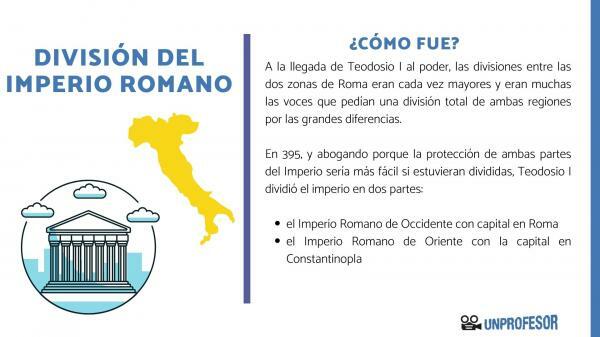Division of the ROMAN EMPIRE

The Roman empire is one of the major civilizations of history, being able to conquer most of the known world and promote a thought throughout Europe that in many respects continues to this day. The influence of the Roman Empire was not always the same, suffering great setbacks during its years of existence, and to talk about one of his worst moments in this lesson from a PROFESSOR we offer you a Summary division of the Roman Empire.
Index
- Causes of the division of the Roman Empire
- Diocletian and the new types of government
- The division of Rome
Causes of the division of the Roman Empire.
To talk about the division of the Roman Empire, we must first of all talk about the background that led to this important decision, the long being 3rd century crisis one of the reasons that forced the great empire to divide.
The crisis of the third century was a period of about 50 years of duration between 235 and 285 in which Rome was plunged by a severe crisis of government, joining the pressures from a series of external peoples and a great economic, political and social crisis that occurred within the empire.
The beginning of this crisis that did so much damage to the emperor and the system of Rome was the death of the emperor Alejandro Severo in 235, causing the appearance of a military anarchy in which there were many generals from Rome who sought access to Roman power through their military careers. This situation of tension together with the weak emperors who occupied the position showed that the breadth of the empire was had become too big, causing attacks by the northern tribes and independence of provinces such as Gaul or Palmyra.
The situation for years in which emperors and warlords had been unable to defend themselves from the external enemies and keeping the empire unified led a number of emperors with Illyrian origins to take the power. Of all these emperors the most prominent was Diocletian, being the person who made Rome pass from the Crisis of the third century to the Low Empire.
Diocletian and the new types of government.
Since his arrival as emperor, Diocletian was clear that the management of the empire had to change, since the extension of the territory together with the growth of external problems made it impossible for a single person to manage an empire that had become so large.
At first Diocletian had the idea in 285 of form a government known as diarquía, sharing power with another emperor, thanks to which one could take care of the western area and another in the eastern area.
The form of government worked for a time but the increase in all the problems on the fronts made Diocletian have the idea of changing the diarchy for a tetrarchy. In this new form of government there were two august and two caesars, managing each part of the Empire in pairs, and the caesars being the successors of the august.
Although to form this new form of government there was a kind of division of the empire in the western and eastern areas, this was not entirely the case, since the Roman Empire was still just one and these zones were a kind of provinces that divided the region in two. Even so, in the following years the differences between both parts of the empire were more and more pronounced, being a clear example that the eastern area used more Greek and that Roman customs were little lost little by little.

The division of Rome.
To finish with this summary of the division of the Roman Empire, we must talk about the reasons that led to this division and how it evolved until it finally disappeared. western empire.
To arrival of Theodosius I to powerBoth parts of the Empire had prospered in a similar way, but the divisions between the two areas were growing, and there were many voices Romans who demanded a total division of both regions due to the increasing differences that for some figures of the time had entailed inequalities.
In 395, and advocating that the protection of both parts of the Empire would be easier if they were divided, Theodosius I divided the empire into two parts:
- the Western Roman Empire with capital in Rome
- the Eastern Roman Empire with the capital at Constantinople
Each of Theodosius' sons received one of the empire's halves, both efforts being a complete disaster by the youth of both leaders.
During the following years, both halves of the empire were differentiating more and more and at certain times their similarities were so minimal that they almost seemed like nations that had never shared similarities. After years of suffering Germanic invasions in 476, the Roman emperor Romulus Augustus was overthrown by the Heruli, ending the last emperor of the West. The Western Roman Empire disappeared, becoming numerous Germanic peoples that were occupying all that land little by little.
The Byzantine Empire
The Eastern Roman Empire, later Byzantine EmpireIt lasted for many more years, in part because the invasions it suffered were less than those generated by the Germans. It was not until 1453 that this region was finally defeated by the Turks, ending with the last vestiges of Rome, and showing that the division of Rome had made a part of Rome survive for much longer than if it had been held together.
If you want to read more articles similar to Division of the Roman Empire: short summary, we recommend that you enter our category of Story.



